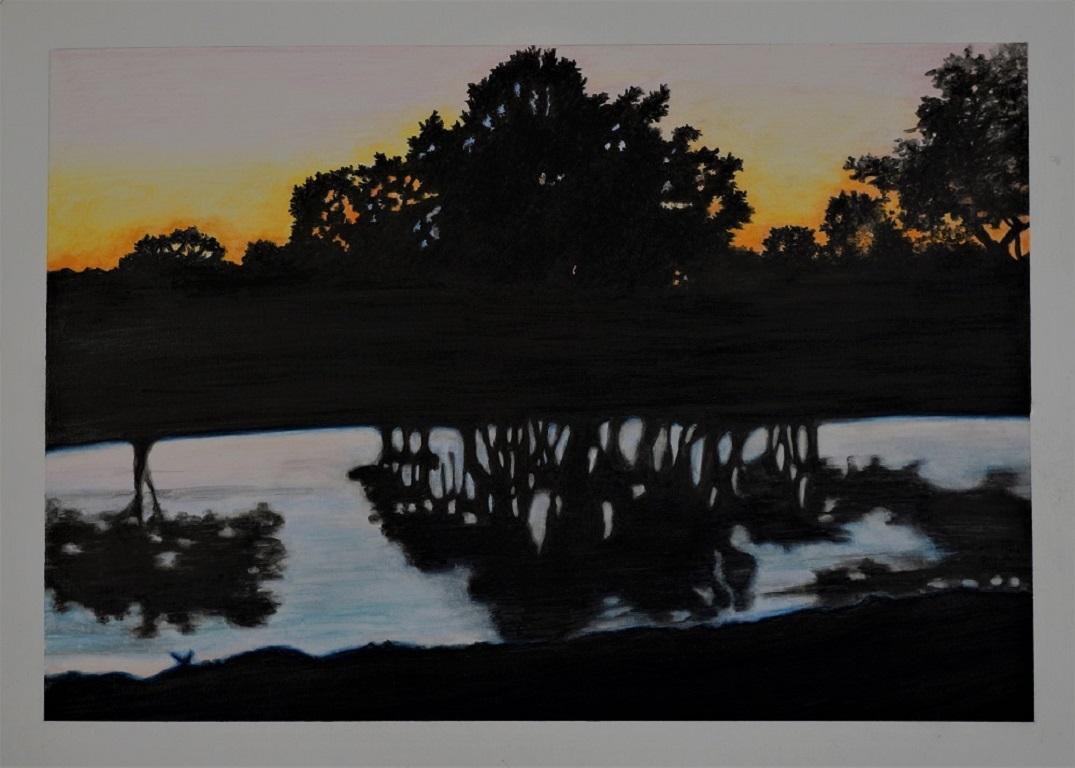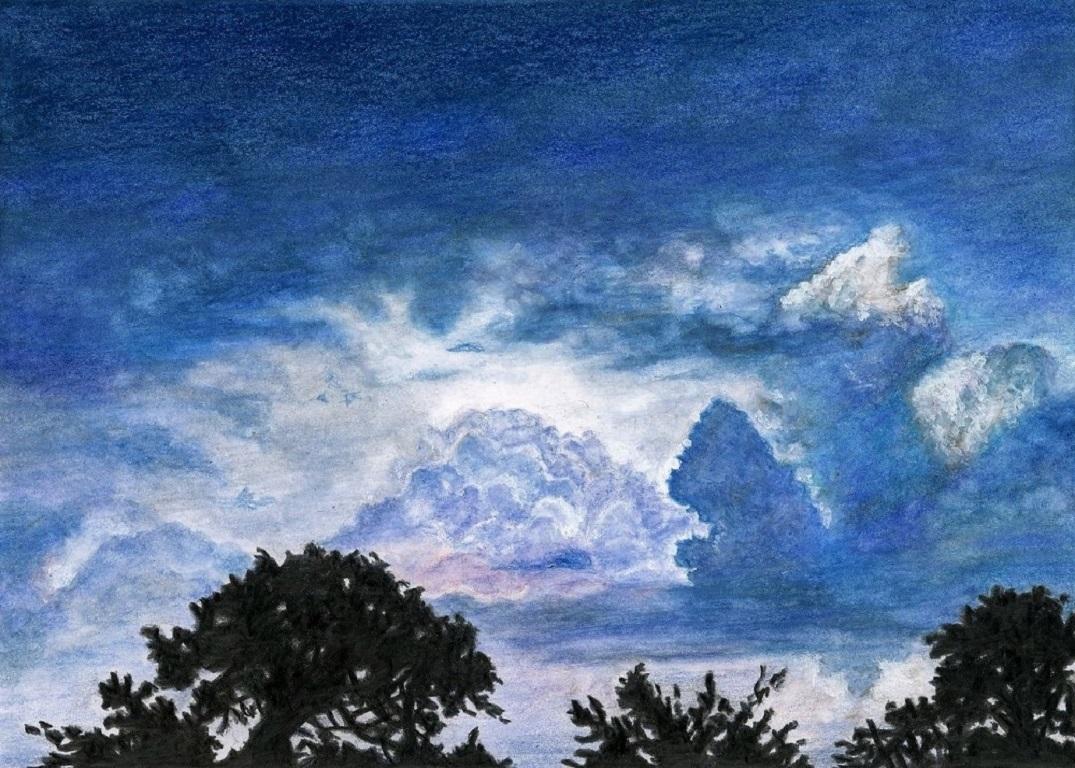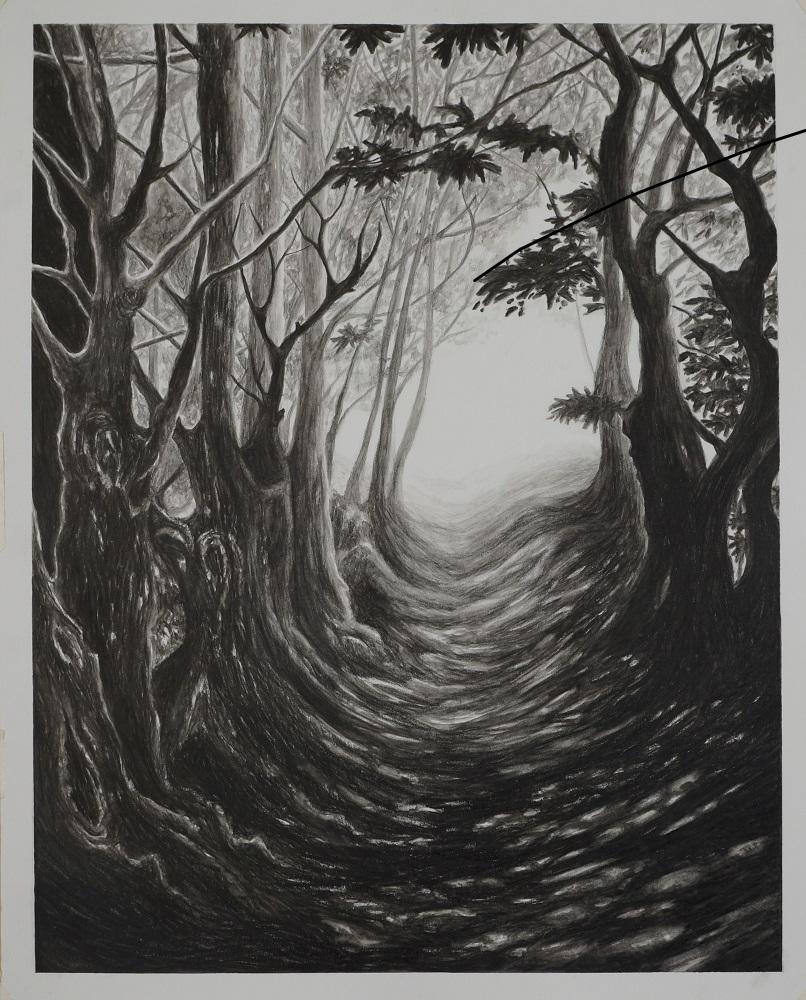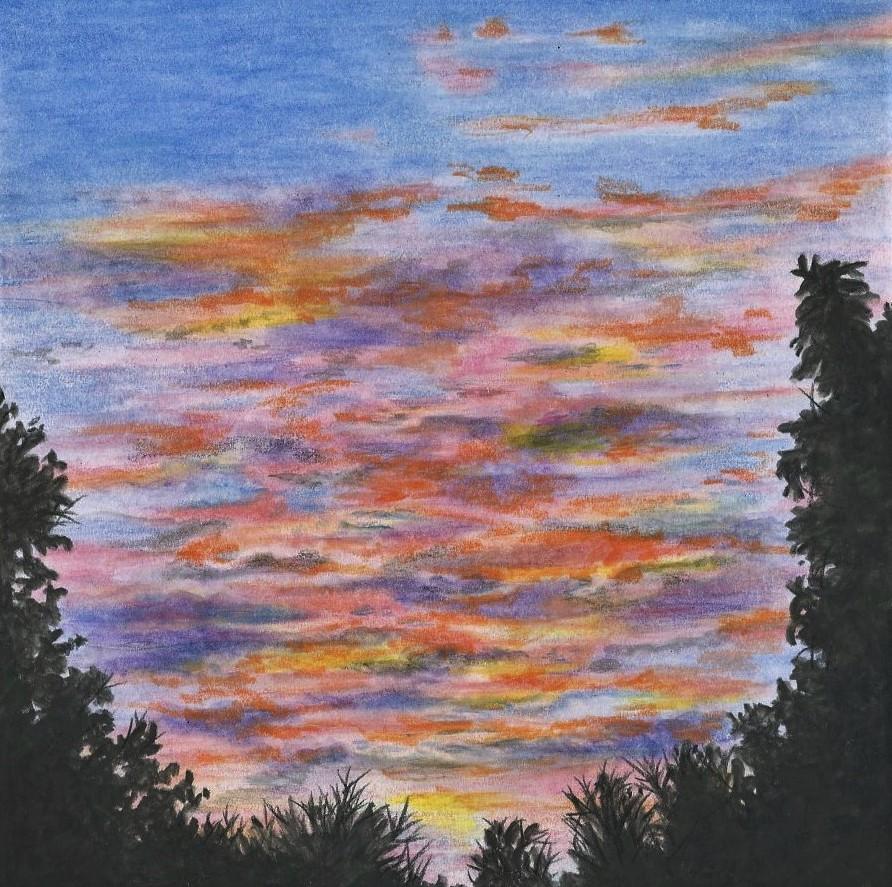Items Similar to In the forest of Durlach - Quiet ripple in a secret place -
Want more images or videos?
Request additional images or videos from the seller
1 of 8
Franz Xaver Gräßel In the forest of Durlach - Quiet ripple in a secret place -1881
1881
About the Item
Franz Xaver Graessel (1861 Oberasbach/Baden - 1948 Emmering). In the forest of Durlach. 1881. Pencil drawing, heightened with white, on grey-green paper. 33 x 41.7 cm. Signed, dated and inscribed by the artist himself: 'Franz Graessel. Durlach, 12 April 1881".
About the artwork
The drawing depicts a view of the woods which, as if sharpening the visual focus, remains diffuse at the edges and does not allow the viewer to locate himself in the picture. As a result, the landscape appears to be an apparition, but at the same time it is given real substance by the solidity of the massive arched bridge made of quarry stone. As the main motif of the painting, the bridge, which blends in with nature like an archaic relic, also acts as a visual guide, drawing attention to the white, raised waters of the stream and the surrounding vegetation. The diffusion of perception that takes place there, however, draws the eye back to the bridge and thus to the overall view. This movement initiating a constant alternation of diffusion and concretion, which is the specific tension of the painting that brings the landscape to life. The materialisation and dematerialisation, however, does not take place solely through the eye's wandering through the picture; it is simultaneously linked to the viewer's approach to and distance from the picture, which loses its richness of detail precisely in the close-up, only to reconfigure itself with increasing distance.
In this work, which dates from Graessel's studies in Karlsruhe, the artist reflects on the emergence of pictorial objectivity. Here, however, nature is more than a mere motif. The real connection between culture and nature is symbolically expressed by the choice of green paper.
The drawing is an impressive testimony to Graessel's mastery of the sprezzatura with which he skilfully applies the most abstract of strokes, which visibly merge towards the centre of the picture. The signature and the exact date prove that Graessel gave this work more than the character of a mere sketch.
About the artist
Franz Graessel grew up in an environment that was to nourish his later key motifs: his parents' house was a mill. After attending the Karlsruhe Academy of Art from 1878 to 1884, where he studied under Carl Hoff, Graessel continued his training at the Munich Academy from 1886 to 1890 as a pupil of Wilhelm von Lindenschmidt. Trained primarily in genre and portrait painting, he initially portrayed the life of Black Forest farmers. From 1894 he turned increasingly to animal painting, concentrating on the depiction of ducks and geese, which earned him the nickname 'Enten-Graessel'. Graessel's work thus parallels that of Alexander Koester (1864-1932), who was also known as 'Duck-Koester'. Koester had begun studying art the year after Graessel left Karlsruhe, also with Carl Hoff, and later, like Graessel, went to Munich. Like Koester, however, Graessel continued to paint portraits and landscapes as well as animals.
In 1900 Graessel turned his back on the big city and moved from Munich to Emmering near Fürstenfeldbruck, where a number of artists who became known as the 'Brucker Maler' settled in Graessel's wake. Due to his national and even international success, Graessel was appointed Royal Academy Professor at the Munich Academy of Fine Arts by Prince Regent Luitpold in 1911. In 1914 the first exhibition of local artists was held in Bruck's town hall, and in 1924 the Fürstenfeldbruck Artists' Association was founded, of which Graessel was honorary chairman.
Graessel was a regular participant in the annual exhibitions at the Glaspalast in Munich, where he often acted as a juror. Franz Hanfstaengel's 'Kunst unserer Zeit' and 'Jugend' regularly published reproductions of Graessel's paintings. Among his most prominent collectors were Prince Regent Luitpold of Bavaria, Kaiser Wilhelm II and the Khedive of Egypt, Said Halim Pasha.
Graessel was a member of the Munich Artists' Association, the Isar Artists' Association, the Munich Watercolourists' Association and the Munich Art Association. He received numerous awards: in 1888 he received the second medal of the academy for his painting 'At Work', which shows his three sisters in the traditional costume of Black Forest farmers; in 1897 he received the second and in 1909 the first gold medal at the International Art Exhibition in Munich. In 1903 Graessel was awarded the Silver State Medal of Salzburg and in 1910 the Silver Medal of the Buenos Aires International Art Exhibition.
Thank you for your interest! I hope I have been able to explain to you the special character of the artwork. If you have any questions of any kind, please feel free to contact me.
I wish you many more discoveries in the realm of art,
Dr Martin Kirves
GERMAN VERSION
Franz Xaver Gräßel [Grässel] (1861 Oberasbach/Baden - 1948 Emmering). Im Durlacher Wald. 1881. Bleistiftzeichnung, weiß gehöht, auf graugrünem Papier. 33 x 41,7 cm. Eigenhändig signiert, datiert und ortsbezeichnet „Franz Gräßel. Durlach, 12. April 1881“.
zum Werk
Die Zeichnung präsentiert eine Waldansicht, die - wie in einer Zuspitzung des visuellen Aufmerksamkeitsfokus - an den Rändern diffus bleibt und auch keinen Betrachterstandort im Bild zulässt. Dadurch wirkt die Szenerie erscheinungshaft, gewinnt durch die Festigkeit der massiven, aus Bruchsteinen zusammenfügten Bogenbrücke aber zugleich an realer Substanz. Als Hauptmotiv des Bildes fungiert die wie ein archaisches Relikt mit der Natur verschmolzene Brücke zugleich als Blickführung, die die Aufmerksamkeit auf das weiß gehöhte Wasser des Bachlaufs und die ihn umgebende Vegetation lenkt. Die dort erfolgende Diffusion der Wahrnehmung führt den Blick aber wieder zur Brücke und damit zur All-Ansicht zurück, so dass ein beständer Wechsel von Diffusion und Konkretion initiiert wird, in welchem die spezifische, die Szenerie verlebendigende Spannung des Bildes gründet. Die Materialisation und Dematerialisation erfolgt aber nicht allein mit dem im Bild umherschweifenden Blick, sie ist zugleich an die Annährung und Entfernung des Betrachters vom Bild gekoppelt, das gerade in der nahsichtigen Betrachtung seine Detailfülle verliert, die sich mit zunehmendem Abstand wieder rekonfiguriert.
In Gräßels Karlsruher Studienzeit fallend, reflektiert der Künstler hier über die Entstehung der Bildgegenständlichkeit. Dabei ist die Natur allerdings mehr als ein bloßer motivischer Anlass. Gerade durch die vom gewählten grünen Papier unterstützte Darstellungsweise kommt die genuine Verbundenheit von Kultur und Natur sinnbildlich zum Ausdruck.
Die Zeichnung ist ein eindrucksvolles Zeugnis, mit welch souveräner Sprezzatura Gräßel gekonnt die abstraktesten Striche setzt, die sich zur Bildmitte hin zusehends motivisch zusammenschließen. Dass Gräßel diesem Werk mehr als den Charakter einer bloßen Skizze beigemessen hat, belegen die Signatur und die taggenaue Datierung.
zum Künstler
Franz Gräßel wuchs in einem Umfeld auf, aus dem sich seine späteren Schlüsselmotive speisen sollten: Das Haus seiner Eltern war ein Mühlbetrieb. Nachdem Gräßel von 1878 bis 1884 die Kunstakademie in Karlsruhe besucht und unter Carl Hoff bis zur Meisterabteilung studiert hatte, setzte er seine Ausbildung von 1886 bis 1890 an der Münchner Akademie als Schüler von Wilhelm von Lindenschmidt fort. Vor allem in der Genre- und Porträtmalerei geschult, porträtierte er zunächst das Leben der Schwarzwaldbauern. Ab 1894 wandte er sich dann verstärkt der Tiermalerei zu, wobei er sich vor allem auf die Darstellung von Enten und Gänsen kaprizierte, was ihm den Beinamen "Enten-Gräßel" eintrug. Damit bildet Gräßels Werk eine Parallele zum Oeuvre Alexander Koesters (1864-1932), der seinerseits als "Enten-Koester" bezeichnet worden ist. Koester hatte im Jahr nach Gräßels Weggang von Karlsruhe, ebenfalls bei Carl Hoff, ein Kunststudium aufgenommen und ist, wie Gräßel, später nach München gegangen. Ebenso wie Koester malte Gräßel neben den Tierdarstellungen aber auch weiterhin Porträt- und Landschaftsbilder.
1900 kehrte Gräßel der Großstadt den Rücken und zog von München nach Emmering bei Fürstenfeldbruck, wo sich in der Nachfolge Gräßels etliche Künstler ansiedelten, die als „Brucker Maler“ bekannt wurden. Aufgrund seines überregionalen, ja internationalen Erfolges wurde Gräßel 1911 von Prinzregent Luitpold zum königlichen Akademie-Professor an der Akademie der Bildenden Künste München ernannt. 1914 wurde im Brucker Rathaus die erste Ausstellung einheimischer Künstler gezeigt und 1924 schließlich die Künstlervereinigung Fürstenfeldbruck gegründet, dessen Ehrenvorsitzender Gräßel war.
Gräßel beschickte regelmäßig die Jahresausstellungen im Münchner Glaspalast, bei denen er häufig auch als Juror fungierte. Franz Hanfstaengels "Kunst unserer Zeit" und die "Jugend" veröffentlichten laufend Reproduktionen von Gräßels Gemälden. Zu seinen prominentesten Sammlern gehörten der Prinzregent Luitpod von Bayern, Kaiser Wilhelm II. und der Kedive von Ägypten, Said Halim Pascha.
Gräßel war Mitglied in der Münchner Künstlergenossenschaft, im Künstlerbund Isar, im Verein Münchner Aquarellisten und im Kunstverein München. Er wurde mit zahlreichen Preisen geehrt: 1888 erhielt er die II. Medaille der Akademie für sein Gemälde "Bei der Arbeit", das seine drei Schwester in der Tracht von Schwarzwaldbäuerinnen zeigt; 1897, anlässlich der Internationalen Kunstausstellung München, die 2. und 1909 die 1. Goldene Medaille. 1903 wurde Gräßel mit der Silberne Staatsmedaille Salzburg und 1910 mit der Silbernen Medaille der Internationale Kunstausstellung Buenos-Aires ausgezeichnet.
Vielen Dank für Ihr Interesse! Ich hoffe, ich habe Ihnen den besonderen Charakter des Kunstwerks näherbringen können. Bei Fragen jeglicher Art können Sie mich gerne kontaktieren.
Ich wünsche Ihnen noch viele Entdeckungen im Reich der Kunst,
Dr. Martin Kirves
- Creator:Franz Xaver Gräßel (1861 - 1948, German)
- Creation Year:1881
- Dimensions:Height: 13 in (33 cm)Width: 16.54 in (42 cm)
- Medium:
- Movement & Style:
- Period:
- Condition:
- Gallery Location:Berlin, DE
- Reference Number:1stDibs: LU2438211895982

About the Seller
5.0
Vetted Seller
These experienced sellers undergo a comprehensive evaluation by our team of in-house experts.
Established in 2014
1stDibs seller since 2023
7 sales on 1stDibs
Typical response time: 6 hours
- ShippingRetrieving quote...Ships From: Berlin, Germany
- Return PolicyA return for this item may be initiated within 14 days of delivery.
More From This SellerView All
- Norwegian Pine Grove - The inner glow of the trees -Located in Berlin, DEThemistokles von Eckenbrecher (1842 Athens - 1921 Goslar), Norwegian pine grove, 1901. Watercolor on blue-green paper, 30 x 22 cm. Signed, dated and inscribed in his own hand "TvE. Fagermes [i.e. Fagermes]. 26.6.[19]01." - Slight crease throughout at left margin, otherwise in good condition. About the artwork Themistokles von Eckenbrecher often traveled to Norway to study the nature that fascinated him there. On June 26, 1901, near the southern Norwegian town of Fagernes, in the summer evening sun, he saw a small pine grove, which he immediately captured in a watercolor. He exposed the trees growing on a small hill in front of the background, so that the pines completely define the picture and combine to form a tense motif. The tension comes from the contrast of form and color. The trunks, growing upward, form a vertical structure that is horizontally penetrated by the spreading branches and the pine needles, which are rendered as a plane. This structural tension is further intensified by the color contrast between the brown-reddish iridescent trunks and branches and the green-toned needlework. Themistokles von Eckenbrecher, however, does not use the observed natural scene as an inspiring model for a dance of color and form that detaches itself from the motif and thus treads the path of abstracting modernism. Its inner vitality is to be brought to light and made aesthetically accessible through the work of art. It is precisely in order to depict the inner vitality of nature that von Eckenbrecher chooses the technique of watercolor, in which the individual details, such as the needles, are not meticulously worked out, but rather a flowing movement is created that unites the contrasts. The trees seem to have formed the twisted trunks out of their own inner strength as they grew, creatingthose tense lineations that the artist has put into the picture. The inner strength continues in the branches and twigs, culminating in the upward growth of the needles. At the same time, the trunks, illuminated by the setting sun, seem to glow from within, adding an almost dramatic dimension to the growing movement. Through the artwork, nature itself is revealed as art. In order to make nature visible as art in the work, von Eckenbrecher exposes the group of trees so that they are bounded from the outside by an all-encompassing contour line and merge into an areal unity that enters into a figure-ground relationship with the blue-greenish watercolor paper. The figure-ground relationship emphasizes the ornamental quality of the natural work of art, which further enforces the artwork character of the group of trees. With the presentation of Themistokles von Eckenbrecher's artistic idea and its realization, it has become clear that the present watercolor is not a study of nature in the sense of a visual note by the artist, which might then be integrated into a larger work context, but a completely independent work of art. This is why von Eckenbrecher signed the watercolor. In addition, it is marked with a place and a date, which confirms that this work of nature presented itself to him in exactly this way at this place at this time. At the same time, the date and place make it clear that the natural work of art has been transferred into the sphere of art and thus removed from the time of the place of nature. About the artist Themistocles' parents instilled a life of travel in their son, who is said to have spoken eleven languages. His father, who was interested in ancient and oriental culture, was a doctor and had married Francesca Magdalena Danelon, an Italian, daughter of the British consul in Trieste. During a stay in Athens - Gustav von Eckenbrecher was a friend of Heinrich von Schliemann and is said to have given him crucial clues as to the location of Troy - Themistokles saw the light of day in 1842. After an interlude in Berlin, where Themistokles was educated at the English-American School, the journey began again. From 1850 to 1857 the family lived in Constantinople, after which the father opened a practice in Potsdam, where Themistokles, who wanted to become a painter, was taught by the court painter Carl Gustav Wegener. In 1861 the von Eckenbrechers left Potsdam and settled in Düsseldorf. There Themistokles received two years of private tuition from Oswald Aschenbach, who greatly admired the talented young artist. After his artistic training, he undertook extensive travels, often accompanied by Prince Peter zu Sayn-Wittgenstein, which took him to northern and eastern Europe, but above all to the Middle East and even to South America. The paintings that resulted from these journeys established his artistic reputation and led to his participation in large panoramas such as the 118 x 15 metre Entry of the Mecca Caravan into Cairo, painted for the City of Hamburg in 1882. 1882 was also the start of a total of 21 study trips to Scandinavia, most of them to Norway, and the unique Norwegian landscape with its rugged fjords became a central motif in his work. Along with Anders Askevold and Adelsteen Normann...Category
Early 1900s Naturalistic Landscape Drawings and Watercolors
MaterialsWatercolor
- Clay jug on a bench - The essence of the clay jar revealed by the sunlight -By Hans Richard von VolkmannLocated in Berlin, DEHans Richard von Volkmann (1860 Halle (Saale) - 1927 ibid.), Clay jug on a bench. Pencil and Watercolour on paper. 20 x 26,7 cm (visible size), 37 x 45 cm (frame), dated and monogrammed lower left "Februar 1890 - HR. V. V." - Minimally tanned. Framed behind glass in a passepartout. About the artwork Using the technique of his early youth - pencil and watercolour - Hans Richard von Volkmann depicts a still life. However, this is not a conventional indoor still life, but an open-air depiction, painted outdoors and not in the studio. It is therefore an open-air painting, characteristic of von Volkmann's oeuvre, which could have been painted in the Willingshausen colony of painters, where open-air painting was programmatically practised there and the artist stayed there that year. And indeed, this painting is a manifesto of open-air painting. Von Volkmann demonstrates that leaving the studio for the light of nature leads to an entirely new quality of art. To prove this, he uses the genre of still life, which can be described as the studio subject par excellence. Moreover, light plays an essential role in the classical still life. It is the real protagonist of the still life. And it is precisely this moment, essential to the still life, that von Volkmann exploits to demonstrate the potential of plein-air painting: He presents the objects as they appear in the sunlight. The date of February and the bare branches in the foreground make it clear that this is a clear winter day in bright sunlight. The delicate plant in the foreground casts a clearly defined shadow, as does the jug. However, the shadow is most pronounced on the jug itself: The underside of the handle appears almost black, making the top, and therefore the jug itself, shine all the more brightly. The shining of the objects in the sunlight is also visible on the bench. As complementary phenomena to the shadow zones, light edges can be seen on the boards of the seats and the upper foot of the bench shines entirely in the light. To achieve this intensity of light, von Volkmann activated the bright white of the painting ground. By depicting the objects in glistening sunlight, von Volkmann demonstrates that this quality of light is only to be found outdoors. And this light leads to a new way of looking at the objects themselves. The jug on the bench seems like an accidental arrangement, as if the artist had stumbled upon this unintentional still life and captured it with fascination. And in this fascination there is a moment of realisation that refers to the objects themselves. It is only when they shine brightly in the sunlight that their true nature is revealed. In this way, sunlight allows the objects to come into their own, so to speak. Sunlight, which is not present in the studio, gives the still life an entirely new dimension of reality, which is also reflected in the colours interwoven by the sunlight: The bench and the jug stand in a harmonious grey-pink contrast to the green of the implied meadow. The emphasis on the jug as the central subject of the picture also implies that the watercolour has not been completed. This non finito inscribes a processuality into the picture, making it clear that something processual has been depicted, the temporality of which has been made artistically permanent. This is why von Volkmann signed the painting and dated it to the month. About the Artist Von Volkmann made his first artistic attempts at the age of 14. He painted many watercolours of his home town of Halle. This laid the foundation for his later outdoor painting. In 1880 his autodidactic beginnings were professionalised with his admission to the Düsseldorf Art Academy. There he studied under Hugo Crola, Heinrich Lauenstein, Johann Peter Theodor Janssen and Eduard von Gebhardt until 1888. Von Volkmann then moved to the Karlsruhe Academy, where he was Gustav Schönleber's master pupil until 1892. In 1883 he came for the first time to Willingshausen, Germany's oldest painters' colony, at the suggestion of his student friend Adolf Lins...Category
1890s Naturalistic Still-life Drawings and Watercolors
MaterialsWatercolor
- Evening Cottage Scene / - Somewhere in Nowhere -Located in Berlin, DEArthur Claude Strachan (1865 Edinburgh - 1954 Minehead), Evening Cottage Scene. Watercolor on paper, mounted, 28 x 46 cm (visible size), 48 x 65 cm (fra...Category
Early 1900s Realist Landscape Drawings and Watercolors
MaterialsPaper
- The Ruins of St. Clement's Church in Visby, Sweden / - Real romanticism -Located in Berlin, DEOtto Günther-Naumburg (1856-1941), The Ruins of St. Clement's Church in Visby, Sweden. Watercolor and ink, heightened with white, on sand-colored paper, mounted on cardboard, 33 x 24...Category
Early 20th Century Realist Landscape Drawings and Watercolors
MaterialsPaper
- Shady hollow way - Into the heart of the forest -By Hans DvoràkLocated in Berlin, DEHans Dvořák (19th century). Shady hollow way in a sunny forest. Watercolour and pen-and-ink drawing, 58.5 x 43 cm (visible size), 70 x 55.5 cm (frame), signed and dated "Hans Dvořák ...Category
1880s Realist Landscape Drawings and Watercolors
MaterialsWatercolor
- High Moorland Landscape in the fog - The world as a transcendent phenomenon -Located in Berlin, DECharles Edward Brittan Jr (1870 Plymouth - 1949). High moor landscape in the fog. Gouache, signed at lower left "Charles E. Brittan", 18 x 34.5 cm (passepartout), 45 x 62 cm (frame)....Category
Early 20th Century Realist Landscape Drawings and Watercolors
MaterialsWatercolor
You May Also Like
- Tree Tu12el, Acrylic Abstract Painting, 2018Located in Boston, MAArtist Commentary: This image is drawn from my imagination and imagery that I am inspired by. Keywords: Landscape Artist Biography: Judith grew up 15 miles north of Milwaukee in t...Category
21st Century and Contemporary Naturalistic Landscape Drawings and Waterc...
MaterialsPaper, Graphite
- Rain Lily, Acrylic Abstract Painting, 2018Located in Boston, MAArtist Commentary: Delicate Texas wildflower. Keywords: Landscape and Nature Artist Biography: Judith grew up 15 miles north of Milwaukee in the town of Mequon, Wisconsin, an old ...Category
21st Century and Contemporary Naturalistic Landscape Drawings and Waterc...
MaterialsColor Pencil, Graphite, Paper
- Follow, Acrylic Abstract Painting, 2018Located in Boston, MAArtist Commentary: This image is drawn from my imagination and imagery that I am inspired by. Keywords: Landscape Artist Biography: Judith grew up 15 miles north of Milwaukee in t...Category
21st Century and Contemporary Naturalistic Landscape Drawings and Waterc...
MaterialsGraphite, Paper
- Nightfall, Original Landscape Drawing, 2018Located in Boston, MAArtist Commentary: A stunning, colorful Texas sunset. Keywords: Landscape & Nature Artist Biography: Judith grew up 15 miles north of Milwaukee in the ...Category
21st Century and Contemporary Naturalistic Landscape Drawings and Waterc...
MaterialsPaper, Watercolor, Pencil
- ThunderLocated in Boston, MAArtist Commentary: A powerful storm was rolling in from west Texas when I captured this image with my camera. I painted it a few years later. The original artwork is matted and frame...Category
21st Century and Contemporary Naturalistic Landscape Drawings and Waterc...
MaterialsPaper, Watercolor, Pencil
- Cattle PondLocated in Boston, MAArtist Commentary: Texas hill country sunset on a warm October evening. Keywords: Landscape Artist Biography: Judith grew up 15 miles north of Milwaukee in the town of Mequon, Wis...Category
21st Century and Contemporary Naturalistic Landscape Drawings and Waterc...
MaterialsPaper, Watercolor, Pencil





